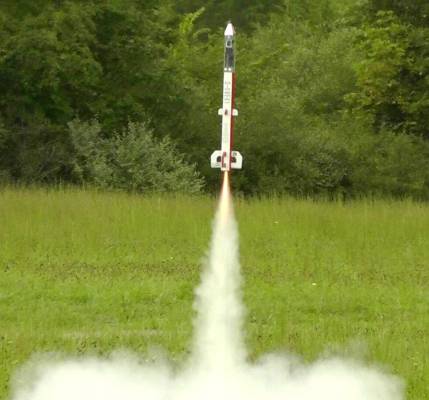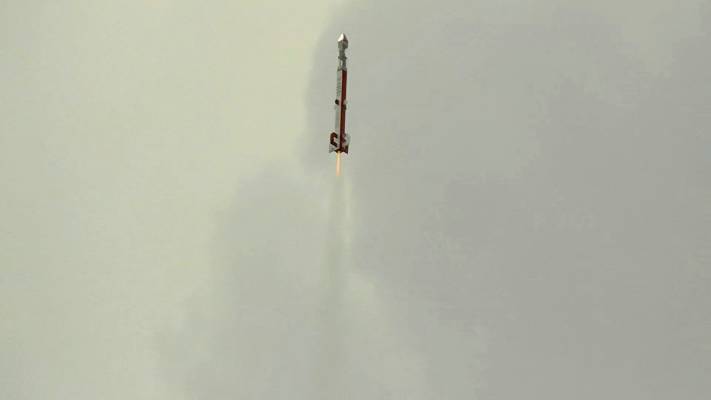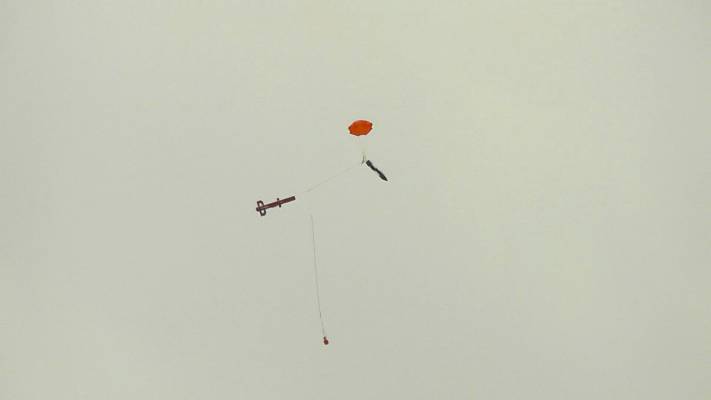The distinguishing feature of this rocket, like all the kits from New Way Space Models, is that the body tube is square instead of the traditional round body. This is a D-powered payload rocket, capable of flying with larger E and F motors as well as a smaller C power. My particular rocket had the payload bay modified to carry a small HD video camera and an altimeter/accelerometer.
I chose this rocket to carry the camera because it can have considerable excess rocket thrust to compensate for the heavy (47 gram) camera. It also was somewhat short and has smaller fins which I suspect / believe will be more stable with the heavy noseweight. My previous camera booster was overstable, which I suspect contributed to somewhat blurry images from the motion, and a tendency to wind-cock and fly at a angle. As a bonus, the square sides of the payload made it easier to install a flat glass window. I had hoped that the clear plastic would be optically clear, but it blurrs and distorts the camera's view. Another bonus is the plastic screws that secure the bulkhead ("connector" according to New Way) and prevent a loss of the electronics. To this I added Nylon screws to secure the nose cone on top also.
With its additional weight, it now is carried by two parachutes: a 19" and a 9" Nylon parachute. (The 9" is only for a redundant backup chute.)
I modified the suggested black/white paint and used red and white to make it more visible in the air and on the ground, to help prevent the loss of a rather expensive payload. I did not use the gold foil supplied by the kit. The construction followed the stock kit, however I modified the clear plastic payload tube to carry a small glass window for the camera to "look out of", because the plastic created too much distortion of the image.
I have not yet given this rocket a test flight yet, so I have no idea how high and how well it will perform by itself or with the additional payload weight. New Way was not helpful in providing any altitude estimates of this kit. My hunch is that it will fly well.
| Flight Date: | 2013-08-31 |
| Rocket Name: | C-Thru |
| Flyer's Name: | Rich DeAngelis |
| Motors: | D12-3 |
| Launch Site: | Fort Indiantown Gap, PA |
| Actual Altitude: | 485 Feet |
After a mostly successful test flight, it was time for the specially-modified C-Thru to go on a photography mission. It was carrying a tiny 47-gram HD video camera. Early in the day when it was sunny, it still seemed a bit hazy so I postponed the flight waiting for the morning fog to burn off. Later in the day it did, but unfortunately it was replaced with sunless overcast skies. Figuring any picture is better than no picture, I sent it up anyways.
The initial test flight showed that the square tube leaves gaps between the wadding and the corners, so I ended up with a burned Nylon parachute that was melted shut. Fortunately I also secured a small 9-inch emergency parachute to the expensive payload. I did the same for this flight. I also packed it with some tissue wadding, then a layer of dog barf, another few squares of tissue, more dog barf and a final layer of tissue wadding. There musta' been a good three or four inches of wadding in there.
The D12 started burning, pushing the rocket off the pad at 9.3 Gs. It burned for 1.8 seconds while averaging 2.5 Gs. Pretty good considering the several ounces of electronics on board. As it fired up, it started rolling to the left a bit, then began rolling to the right at least one or two rotations, but still going pretty straight up. At motor burnout it was travelling at 101 mph. It then coasted to 461 feet where the ejection fired just 2/10 seconds early. With the momentum, it continued up another 8/10 seconds and climbed 24 feet to an apogee of 485 feet.
All that wadding blew out and appeared as though it exploded, but still the main chute was charred and didn't open at all. It remained on the end of a long shock cord in a tightly packed bundle. Again the emergency 9-inch parachute attached directly to the payload saved the day. The rocket returned at 13 mph, landing in 27.4 seconds. All was safe as it rested about 200 feet from the launch pad. Nothing was damaged and the resulting video was fine. The considerable turbulence from the failed parachute made this video quite shaky, sometimes blurred, and often directed at the lifeless, dull gray sky.
This rocket certainly needs a good Nomex sheet. Hopefully I can come up with a solution to the turbulence before the next nice, sunny day.
| Stage | Motor(s) |
|---|---|
| 1 | Estes D12-3 |
 |
 |


